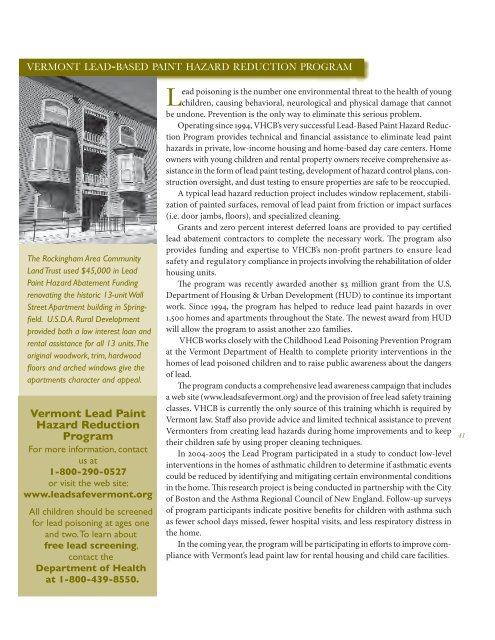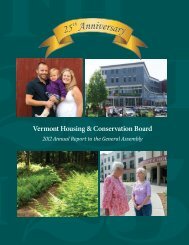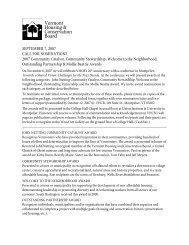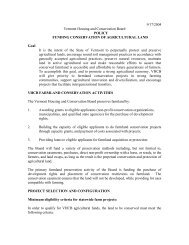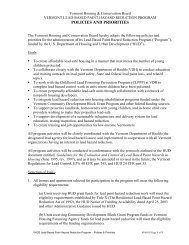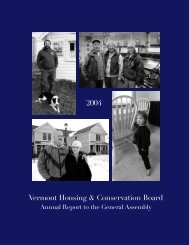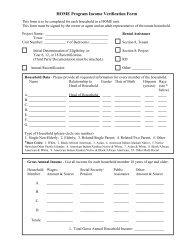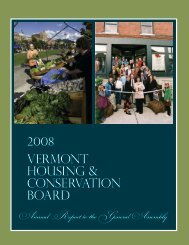Vermont Housing Conservation Board 2005 - Vermont Housing and ...
Vermont Housing Conservation Board 2005 - Vermont Housing and ...
Vermont Housing Conservation Board 2005 - Vermont Housing and ...
You also want an ePaper? Increase the reach of your titles
YUMPU automatically turns print PDFs into web optimized ePapers that Google loves.
VERMONT LEAD-BASED PAINT HAZARD REDUCTION PROGRAM<br />
The Rockingham Area Community<br />
L<strong>and</strong> Trust used $45,000 in Lead<br />
Paint Hazard Abatement Funding<br />
renovating the historic 13-unit Wall<br />
Street Apartment building in Springfi<br />
eld. U.S.D.A. Rural Development<br />
provided both a low interest loan <strong>and</strong><br />
rental assistance for all 13 units. The<br />
original woodwork, trim, hardwood<br />
fl oors <strong>and</strong> arched windows give the<br />
apartments character <strong>and</strong> appeal.<br />
<strong>Vermont</strong> Lead Paint<br />
Hazard Reduction<br />
Program<br />
For more information, contact<br />
us at<br />
1-800-290-0527<br />
or visit the web site:<br />
www.leadsafevermont.org<br />
All children should be screened<br />
for lead poisoning at ages one<br />
<strong>and</strong> two. To learn about<br />
free lead screening,<br />
contact the<br />
Department of Health<br />
at 1-800-439-8550.<br />
Lead poisoning is the number one environmental threat to the health of young<br />
children, causing behavioral, neurological <strong>and</strong> physical damage that cannot<br />
be undone. Prevention is the only way to eliminate this serious problem.<br />
Operating since 1994, VHCB’s very successful Lead-Based Paint Hazard Reduction<br />
Program provides technical <strong>and</strong> financial assistance to eliminate lead paint<br />
hazards in private, low-income housing <strong>and</strong> home-based day care centers. Home<br />
owners with young children <strong>and</strong> rental property owners receive comprehensive assistance<br />
in the form of lead paint testing, development of hazard control plans, construction<br />
oversight, <strong>and</strong> dust testing to ensure properties are safe to be reoccupied.<br />
A typical lead hazard reduction project includes window replacement, stabilization<br />
of painted surfaces, removal of lead paint from friction or impact surfaces<br />
(i.e. door jambs, floors), <strong>and</strong> specialized cleaning.<br />
Grants <strong>and</strong> zero percent interest deferred loans are provided to pay certified<br />
lead abatement contractors to complete the necessary work. The program also<br />
provides funding <strong>and</strong> expertise to VHCB’s non-profit partners to ensure lead<br />
safety <strong>and</strong> regulatory compliance in projects involving the rehabilitation of older<br />
housing units.<br />
The program was recently awarded another 3 million grant from the U.S.<br />
Department of <strong>Housing</strong> & Urban Development (HUD) to continue its important<br />
work. Since 1994, the program has helped to reduce lead paint hazards in over<br />
1,500 homes <strong>and</strong> apartments throughout the State. The newest award from HUD<br />
will allow the program to assist another 220 families.<br />
VHCB works closely with the Childhood Lead Poisoning Prevention Program<br />
at the <strong>Vermont</strong> Department of Health to complete priority interventions in the<br />
homes of lead poisoned children <strong>and</strong> to raise public awareness about the dangers<br />
of lead.<br />
The program conducts a comprehensive lead awareness campaign that includes<br />
a web site (www.leadsafevermont.org) <strong>and</strong> the provision of free lead safety training<br />
classes. VHCB is currently the only source of this training whichh is required by<br />
<strong>Vermont</strong> law. Staff also provide advice <strong>and</strong> limited technical assistance to prevent<br />
<strong>Vermont</strong>ers from creating lead hazards during home improvements <strong>and</strong> to keep<br />
their children safe by using proper cleaning techniques.<br />
In 2004-<strong>2005</strong> the Lead Program participated in a study to conduct low-level<br />
interventions in the homes of asthmatic children to determine if asthmatic events<br />
could be reduced by identifying <strong>and</strong> mitigating certain environmental conditions<br />
in the home. This research project is being conducted in partnership with the City<br />
of Boston <strong>and</strong> the Asthma Regional Council of New Engl<strong>and</strong>. Follow-up surveys<br />
of program participants indicate positive benefits for children with asthma such<br />
as fewer school days missed, fewer hospital visits, <strong>and</strong> less respiratory distress in<br />
the home.<br />
In the coming year, the program will be participating in efforts to improve compliance<br />
with <strong>Vermont</strong>’s lead paint law for rental housing <strong>and</strong> child care facilities.<br />
41


